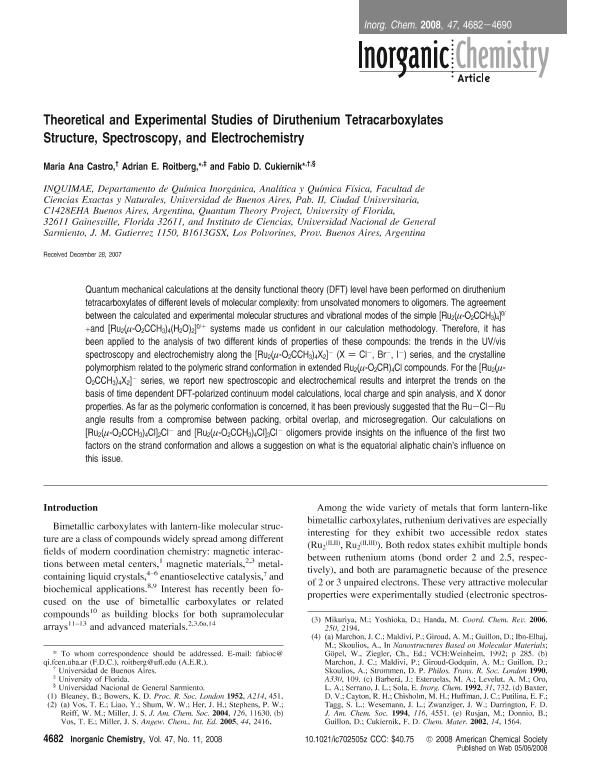Mostrar el registro sencillo del ítem
dc.contributor.author
Castro, Maria Ana

dc.contributor.author
Roitberg, Adrián

dc.contributor.author
Cukiernik, Fabio Daniel

dc.date.available
2019-04-29T23:12:43Z
dc.date.issued
2008-06
dc.identifier.citation
Castro, Maria Ana; Roitberg, Adrián; Cukiernik, Fabio Daniel; Theoretical and experimental studies of diruthenium tetracarboxylates structure, spectroscopy, and electrochemistry; American Chemical Society; Inorganic Chemistry; 47; 11; 6-2008; 4682-4690
dc.identifier.issn
0020-1669
dc.identifier.uri
http://hdl.handle.net/11336/75271
dc.description.abstract
Quantum mechanical calculations at the density functional theory (DFT) level have been performed on diruthenium tetracarboxylates of different levels of molecular complexity: from unsolvated monomers to oligomers. The agreement between the calculated and experimental molecular structures and vibrational modes of the simple [Ru 2 (μ-O 2 CCH 3 ) 4 ] 0/ +and [Ru 2 (μ-O 2 CCH 3 ) 4 (H 2 O) 2 ] 10/+ systems made us confident in our calculation methodology. Therefore, it has been applied to the analysis of two different kinds of properties of these compounds: the trends in the UV/vis spectroscopy and electrochemistry along the [Ru 2 (μ-O 2 CCH 3 ) 4 X 2 ] - (X = Cl - , Br - , I) series, and the crystalline polymorphism related to the polymeric strand conformation in extended Ru 2 (μ-O 2 CR) 4 Cl compounds. For the [Ru 2 (μ-O 2 CCH 3 ) 4 X 2 ] - series, we report new spectroscopic and electrochemical results and interpret the trends on the basis of time dependent DFT-polarized continuum model calculations, local charge and spin analysis, and X donor properties. As far as the polymeric conformation is concerned, it has been previously suggested that the Ru-Cl-Ru angle results from a compromise between packing, orbital overlap, and microsegregation. Our calculations on [RU 2 (μ-O 2 CCH 3 ) 4 Cl] 2 Cl - and [Ru 2 (μ-O 2 CCH 3 ) 4 Cl] 3 Cl - oligomers provide insights on the influence of the first two factors on the strand conformation and allows a suggestion on what is the equatorial aliphatic chain's influence on this issue.
dc.format
application/pdf
dc.language.iso
eng
dc.publisher
American Chemical Society

dc.rights
info:eu-repo/semantics/openAccess
dc.rights.uri
https://creativecommons.org/licenses/by-nc-sa/2.5/ar/
dc.subject
Dft
dc.subject.classification
Otras Ciencias Químicas

dc.subject.classification
Ciencias Químicas

dc.subject.classification
CIENCIAS NATURALES Y EXACTAS

dc.title
Theoretical and experimental studies of diruthenium tetracarboxylates structure, spectroscopy, and electrochemistry
dc.type
info:eu-repo/semantics/article
dc.type
info:ar-repo/semantics/artículo
dc.type
info:eu-repo/semantics/publishedVersion
dc.date.updated
2019-03-27T17:55:22Z
dc.journal.volume
47
dc.journal.number
11
dc.journal.pagination
4682-4690
dc.journal.pais
Estados Unidos

dc.description.fil
Fil: Castro, Maria Ana. Consejo Nacional de Investigaciones Científicas y Técnicas. Oficina de Coordinación Administrativa Ciudad Universitaria. Instituto de Química, Física de los Materiales, Medioambiente y Energía. Universidad de Buenos Aires. Facultad de Ciencias Exactas y Naturales. Instituto de Química, Física de los Materiales, Medioambiente y Energía; Argentina
dc.description.fil
Fil: Roitberg, Adrián. University of Florida; Estados Unidos
dc.description.fil
Fil: Cukiernik, Fabio Daniel. Universidad Nacional de General Sarmiento. Instituto de Ciencias; Argentina. Consejo Nacional de Investigaciones Científicas y Técnicas; Argentina
dc.journal.title
Inorganic Chemistry

dc.relation.alternativeid
info:eu-repo/semantics/altIdentifier/doi/http://dx.doi.org/10.1021/ic702505z
dc.relation.alternativeid
info:eu-repo/semantics/altIdentifier/url/https://pubs.acs.org/doi/10.1021/ic702505z
Archivos asociados
